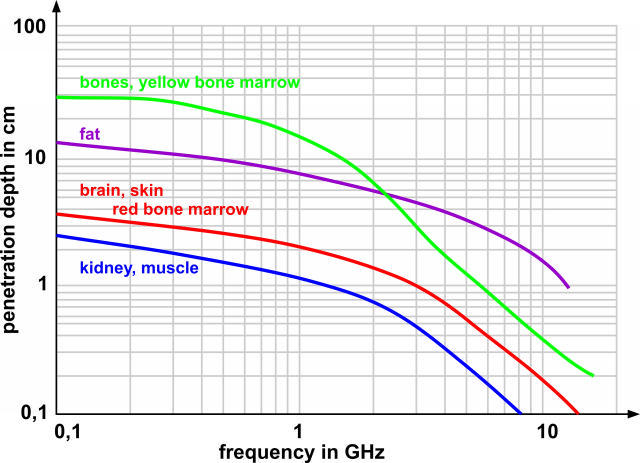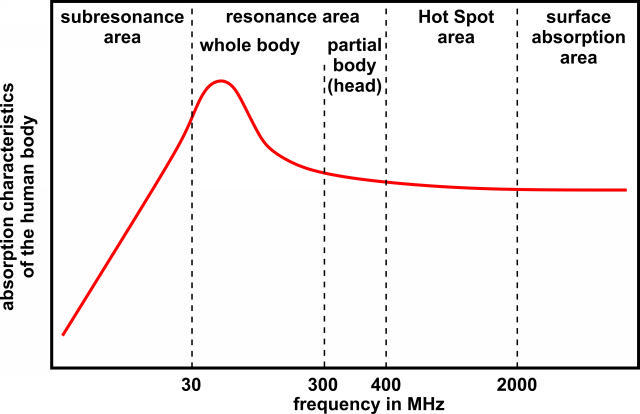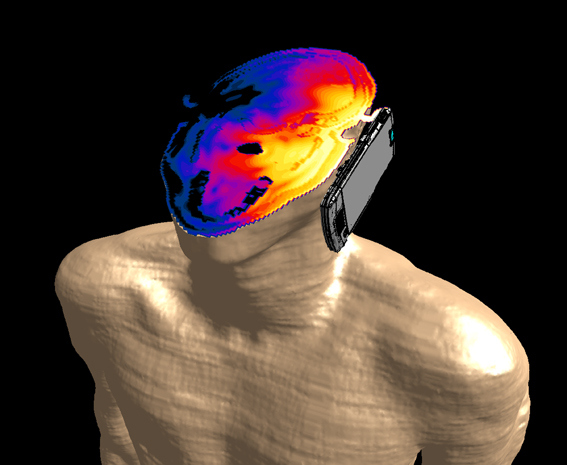Radio frequency (10 MHz–300 GHz)
The radiofrequency field has an electric and a magnetic field component (cf. Electromagnetic fields). Thermal effects are the main possible effects on humans and biological systems. They are caused by the periodical movement stimulation of dipole molecules and charge carriers, which can move and rotate freely (e.g. water molecules in water, body fluids or tissues containing water). During this process, the field components exert an action of force on charged groups of the dipole molecules and charge carriers resulting in a torque affecting the whole molecules and causing the charge carriers to rotate. Heat is generated by friction between rotating molecules and/or moving charge carriers of other atoms
The frequency of the field, the strength of the field and the composition of the tissue in the body (water, fat, protein and salt content) play an important role regarding the amount of energy which is absorbed in body tissues from the radiofrequency field via heat conversion. The higher the frequency of the electromagnetic field the stronger the absorption at the body surface, therefore the higher the frequency the shorter the distance the field can penetrate into the body. The relative penetration depth is defined as the point in the tissue at which an electromagnetic field reaches only approximately 37% of its output amplitude. However, the absolute depth of penetration, i.e. how deep the field can penetrate into the body, also depends on the output field strength. The absolute depth of penetration is generally larger when the output field strength is high compared to a low output field strength.
The electric properties of the tissue, as e.g. conductivity, are governed by the tissue composition and distribution of water molecules, ions and other molecules. This influences the level of absorption of the field in different tissues. A higher conductivity due to e.g. a higher water or salt content, increase the interaction of the field with the tissue and thus the thermal effect. Hence, the tissue heating does not increase steadily from the outside to the inside of the body, instead, there are areas in the body with higher local heating (so called hot spots) and areas with lower heating compared to the surrounding tissues. Bone and fatty tissue, for example, are heated less than other tissues because of their low water content. The depth of penetration is associated with the tissue-depending thermal effect. It is higher in brain, fatty and bone tissues than in muscle tissue (see Figure), as muscle tissue absorbs the field to a greater extent and thus the field energy is converted into heat most efficiently. The average depth of penetration of fields is, for example, approximately 1.5 – 0.5 cm in muscle tissue in the lower GHz band (frequency range 0.5 – 2.5 GHz, used in mobile communication and microwave ovens), and above 10 GHz, it is only about 0.2 mm and less.

In whole body absorption, the magnitude of interaction of the field with the body (the so called coupling), i.e. the amount of the field energy which actually affects the body and contributes to the heating, depends on the frequency-dependent resonance of the whole body. For adults, the resonance range for maximum absorption is approximately between 30 and 100 MHz (see Figure) because the body dimensions and wavelength of the field are in the same order of magnitude (the so called antenna effect, which occurs when the body height matches half of the wavelength – e.g. at a body height of 1.80 m, it is a 83.3 MHz field with a wavelength of 3.60 m). Also the posture plays an important role in that context (e.g. standing, sitting, arms stretched). Hence, body height and posture influence the whole body absorption of radiofrequency fields in the resonance range. This implies that the resonant frequency of children is higher than the resonant frequency of adults because of their smaller size (e.g. the maximum absorption for 1.00 m body height is at 150 MHz).

At close range to field sources with frequencies of approximately 300 MHz and higher, however, absorption occurs increasingly only in parts of the body (partial body absorption) as a result of the decreasing wavelengths at these frequencies compared to the body dimensions and the proximity of the transmitter, e.g. a mobile phone, to the body (see Figures “absorption of radiofrequency fields” and “partial-body absorption in the head”). Still, if the field source at such frequencies is far away (far field conditions, e.g. in the case of mobile communications antennae; cf. chapter Mobile communication), a small fraction of the transmitted energy is absorbed by the whole body (whole body absorption). Thus, whole body absorption also occurs above 300 MHz if the field source is located far away from the body. With increasing frequency, only superficial tissues of the body are affected by this due to the elucidated reasons.

For the determination and assessment of the field absorption in the body, the specific absorption rate (SAR) is used in the frequency range from 3 kHz to 10 GHz (cf. Basic restrictions; regarding partial body and whole body SAR: cf. section “Mobile phones and smartphones” in chapter Mobile communication and section “Limit values of mobile communication systems” in chapter Limit values in Germany (general public)).